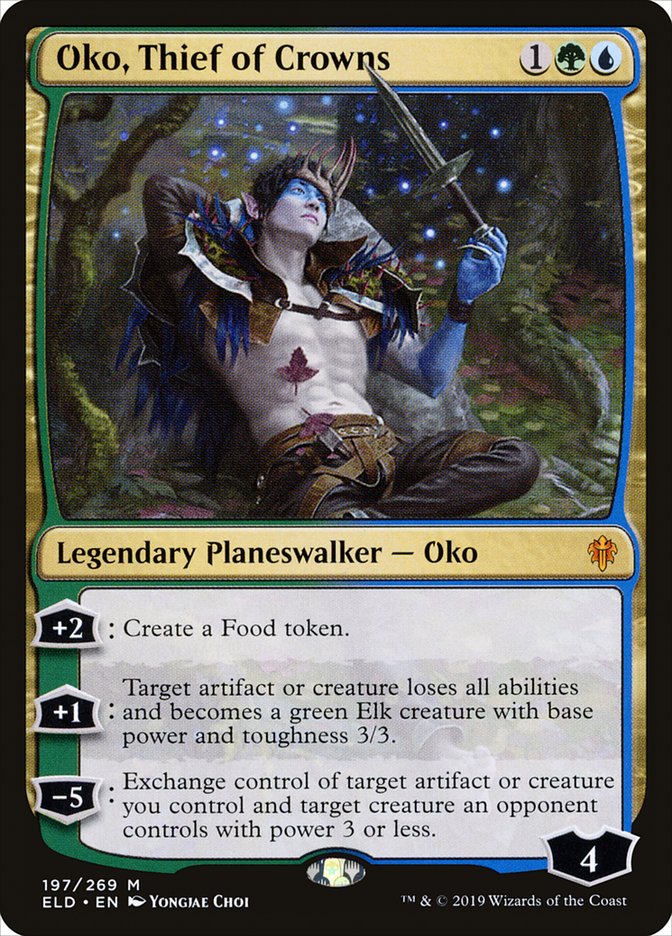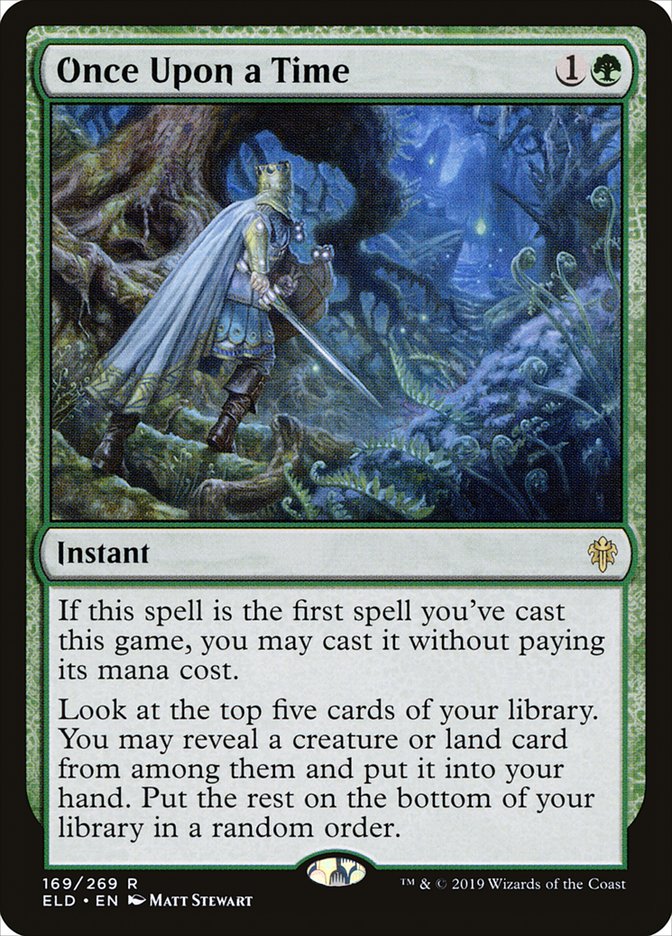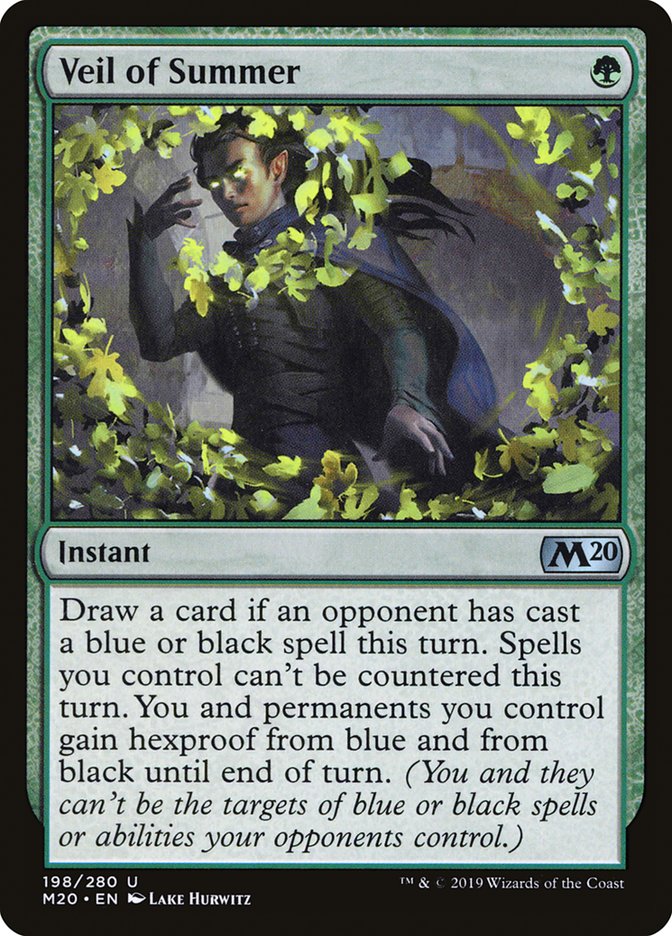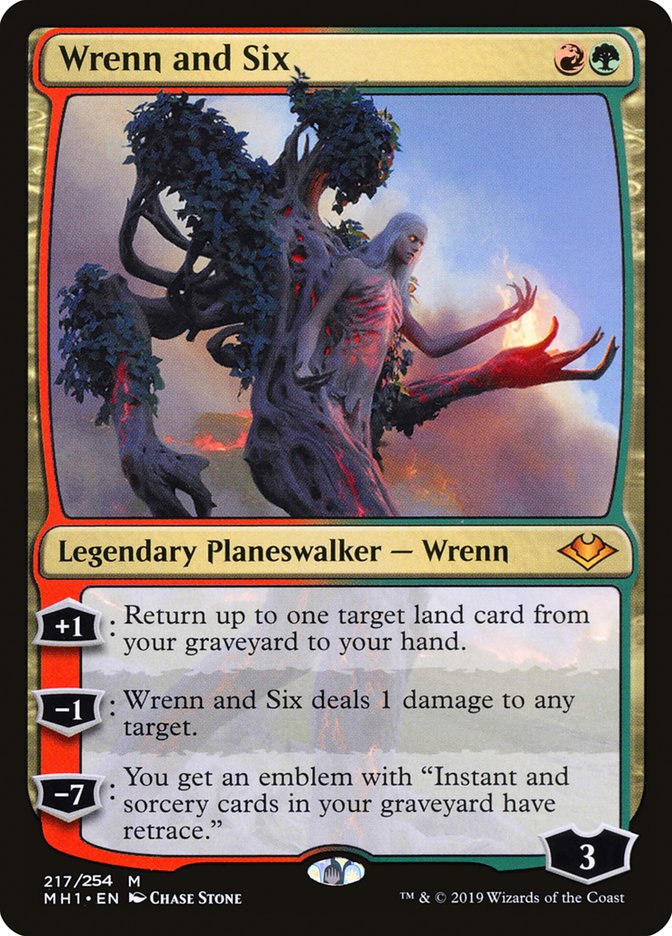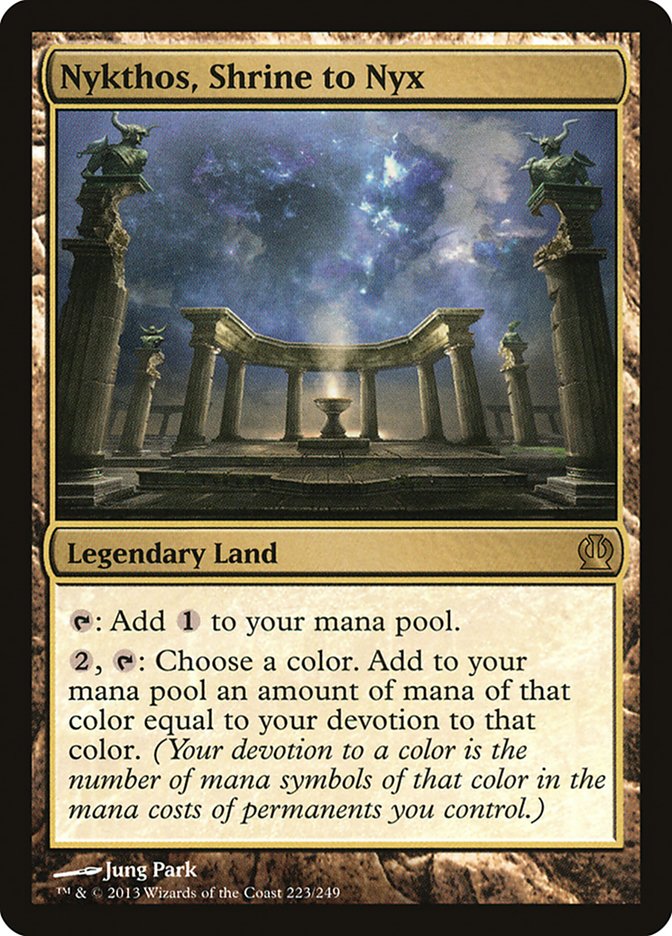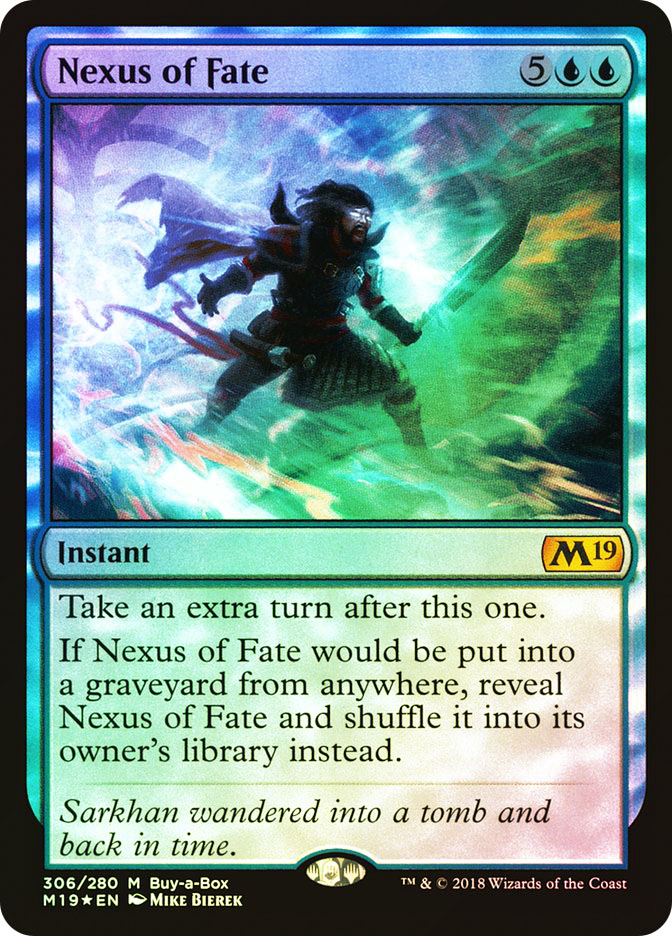Welcome to another edition of Fact or Fiction! Today Ari Lax, Sam Black, and Shaheen Soorani are here to give their takes on five statements on the November 18th Banned and Restricted announcements. Don’t forget to vote for the winner at the end!
1. Banning Oko, Thief of Crowns in Standard was a good decision.
Ari Lax: Fact. Five days after Oko, Thief of Crowns was previewed, I pegged it as problematic. It was even worse than I expected.
The card churns out lifegain and bodies to smush aggro. It churns out 3/3s to crush control decks and opposing planeswalkers. It bricks all the cool creatures and artifacts you could go over the top with. It’s stupidly undercosted such that it undercuts all the other threats you can play. The ultimate is even a joke, in that it fires off the turn after Oko resolves while leaving it on the battlefield and horribly negating your opponent’s turn.
Banning Oko, Thief of Crowns with Field of the Dead a month ago was a good decision. I guess banning it today was the next best-one.
Sam Black: Fact. Yes, banning expensive cards sucks, and yes, banning the face of the set sucks, but at least the card is so ridiculously over the top that it’ll retain or regain most its value because it’s good in non-rotating formats as well. At this point, there was no way they were fooling anyone; Oko was an egregious mistake and there’s simply no way to make a playable Standard format where it was legal.
Trying to ban around Oko couldn’t have solved the problems and would just frustrate people while they lost faith in WotC and predicted a ban as soon as the next set hit the shelves.
Shaheen Soorani: Fact. Mistakes in development happen. Some of them are small and formats they exist in are not poisoned. The issue with this mistake is that it was one of the largest that WotC has had in the modern era of Magic. It is a huge gamble to create a balanced planeswalker at three mana and the abilities, starting loyalty, and accompanying cards of Gilded Goose / Once Upon a Time destroyed Standard.
Looking at other three-mana planeswalkers of the past, their loyalty never exceeded reasonable standards. A planeswalker must be able to be attacked down when it comes down on Turn 3 and anything that is immune to that fate is not a reasonable card to print. Oko not only defended itself with crafted creatures, it also made it impossible for a medium-powered creature to do any damage as a 3/3 Elk. Not only did this card ruin Standard, it has also made fans of the game question how this one made it through.
2. Banning Once Upon a Time in Standard was a good decision.
Ari Lax: Fact. I would think Wizards Play Design would have “Free cantrips are a bad idea!” on a whiteboard somewhere, and every time someone suggests one they make them sit in the Oubliette conference room in the basement for a day and think about what they have done. I guess they don’t.
Once Upon a Time blatantly violates this concept of FIRE design they throw around. Replayable? Nope, a huge part of replayability in Magic is game diversity and Once Upon a Time shreds that. Exciting? Again, repetitive gameplay breaks the illusion of unexpected exciting moments. Inviting? Your deck is going to play against the same stupid perfect draw every time; it is not inviting to get bounced over and over by that and have no chance. Fun? See the last three points.
Not even putting Once Upon a Time in a card file was a good decision. I guess banning it today was the next-best one.
Sam Black: Fact. There’s never been any possible advantage to printing Once Upon a Time or allowing it to be played in any format. I think it’s actually more damning of the state of Magic development that this saw print than Oko. The consistency that it offered in conjunction with the London mulligan and a Standard format where some cards were far more powerful than other cards meant that it was strategically optimal to mulligan normal hands to find the kind of hands players used to call “god draws” before they happened every game.
Furthermore, mana in Standard was such that it was impossible for multicolored decks without Once Upon a Time to reasonably compete with the consistency of decks with Once Upon a Time to the point where I think “splashing for fixing” in Rakdos Sacrifice by playing Jund for Gilded Goose and Once Upon a Time likely made the deck more consistent and better at casting its red and black spells. The effect is so dramatic that I’ve felt pressure to include Once Upon a Time in every Pioneer deck, even if I don’t have a lot of creatures, just to make my mana work, and Pioneer has much better mana than Standard.
I can only hope it doesn’t take long for Once Upon a Time to get banned from every other format.
Shaheen Soorani: Fact. Banning Oko isn’t enough to combat the dominance of green in Standard. Free spells have been the bane of Magic’s existence and Once Upon a Time is a perfect reminder of that. In Magic, people mulligan and snag a better hand that doesn’t have the requisite lands and spells to be competitive. Cards like Once Upon a Time prevent entire archetypes from doing that, for the low price of having Forest in your list.
Cards like Ponder, Preordain, and Gitaxian Probe have been removed or restricted in older formats to force a level of inconsistency. Consistency is often misconstrued as optimal or intentional from Play Design’s perspective, but the opposite is much closer to the truth. When decks have a fail rate or builds look different to promote a higher level of redundancy at the expense of brute power, formats are healthier. This motivates some to go all-in with pure aggro, while others sacrifice some of that power for a deck with a bit more consistency that doesn’t kill as quickly. Once Upon a Time creates stale gameplay, restricted deck choice, and an unfair edge over all other colors/strategies. It had to go.
3. Banning Veil of Summer in Standard was a good decision.
Ari Lax: Fact. I can imagine a world where Veil of Summer was the hero, where blue and black removal was too good, and it played an important role keeping green at parity. That world probably ended around 2003 when Counterspell rotated out of Standard with the printing of Eighth Edition, back when Compost was considered a fair card.
These days you are playing against cards like Murderous Rider, which are positioned at more expensive costs with upsides that assume they resolve. Thought Erasure is the only card in Standard I would consider a worthy opponent for Veil of Summer.
I also don’t want to think about all the random stuff that Veil of Summer might hose moving forward. The card’s breadth is too much compared to previous options. Saving something from a counter or removal spell is fine. But then you add stopping discard. Or something like Bump in the Night. Or Angrath’s Rampage or Priest of Forgotten Gods. It’s just too much, and the format is better off if every blue or black card can’t accidentally fail the Veil of Summer test some way.
Sam Black: Fact. I care less about crafting a specific environment than just not playing with stupid cards. Veil of Summer was another huge mistake that’s just far too good at doing what it does and too oppressive of reactive strategies. It shouldn’t have seen print and I’m comfortable with banning it in any or all formats.
People half-joke about it being a one-mana Cryptic Command. It’s narrower, but broad enough that against a huge swath of possible decks, you’ll always get that value, and that simply makes it too hard to play any of those decks. I’ve tried building Dimir-based control decks that look pretty fun in Standard, but you literally just can’t compete after your opponent gets to sideboard in Veil of Summer.
Shaheen Soorani: Super Fact. Veil of Summer is a confirmed mistake from parties that created it, played it, and played against it. There has never been a hate card more egregiously overpowered than this one, completely nullifying every black removal spell and control strategy near it. Once it was banned in Pioneer last week, I wrote confidently that it would also be taken out of Standard on November 18th.
Hate cards are necessary for Magic and I’m glad they pushed the boundary with this one. Veil of Summer missed the mark by a mile and could have been more effective with a bit of tweaking. This at two mana would have probably been fine, or if it didn’t cantrip at one-mana. You’ll hear the wails of those comparing it to Autumn’s Veil if it came nerfed, but it would still be clearly better. Also, times have changed in competitive Magic, and making your Nissa, Who Shakes the World easily resolve for one mana is quite the deal. With Veil of Summer removed, control crawls back into relevancy and is joined by midrange decks that dream of destroying a creature without losing the game on the spot for a single green mana.
4. Banning Wrenn and Six in Legacy was a good decision.
Ari Lax: Fact. This was the same decision as banning Deathrite Shaman last year.
The blue tempo base in Legacy is constrained by having to answer too many threats at once. You only have fifteen sideboard cards to cover Show and Tell, Storm, Death and Taxes, Chalice of the Void, Hogaak, Dark Depths, the list goes on.
Wrenn and Six was just a good card for these blue decks as a cheap threat that leveraged Wasteland. It also effortlessly pushed out a large portion of those previously mentioned threats to the blue deck. That meant Temur Delver or Four-Color Control could cover everything else with the sideboard and the format became a condensed mess.
I’m still not sure we are out of the woods with this ban. Force of Negation and Arcum’s Astrolabe and Oko, Thief of Crowns are all scary extensions of the blue base. It might be time to examine a more fundamental ban if we end up back in the same situation next year.
Sam Black: Fact. The interaction between Wrenn and Six and Wasteland simply isn’t reasonable. On top of that, Thalia, Guardian of Thraben is likely important to the health of Legacy as a necessary check on the strength of cantrips. Wrenn and Six on its face pushes out too many strategies, just on paper. Combining this theoretical analysis with MTGO data that Temur Delver with Wrenn and Six was favored against literally all the other ten most played decks in Legacy paints a pretty clear picture that Legacy was likely in a less healthy place than Standard, just with less serious attention.
Shaheen Soorani: Fact. Wrenn and Six wasn’t on my radar, as Legacy isn’t at the forefront of Magic discussion these days. After winning the Team Constructed Open in Philly earlier this year, I witnessed the power of the two-mana planeswalker with Wasteland and it was a spectacle. Peter Ingram locked out opponents on Turn 3 too often to be okay and I knew it would eventually get removed.
Unfortunately for me, I was ready to roll out some Temur Delver at GP Bologna and this announcement hit me hard. There isn’t a fair deck out there with Brainstorm that hasn’t switched to red to incorporate Wrenn & Six and that should have been a huge red flag for me. When all aggro, control, and midrange decks move their mana base to add Gruul, the card has fully homogenized the fair deck choices of Legacy. After the dust settles here, players will retire back to their favorite, timeless strategies that Legacy has to offer. The only wildcard is Urza, Lord High Artificer and its impact on the plethora of free artifacts the old format has.
5. Something should have been banned in Monday’s Pioneer B&R announcement.
Ari Lax: Fact, but whatever. Once Upon a Time should be unprinted, or at least removed from every format where the Top 10 cards are mostly creatures. But that won’t actually “fix” Pioneer.
Yesterday I covered how every single good Pioneer deck is made of cascading overpowered threats clustered low on the curve. The answers to effectively fight back don’t exist in the card pool, and there’s another set of great threats waiting right behind Smuggler’s Copter to step up in the event of a ban. The format is going to be absolutely centered around finding a couple of ways to steal the initiative on the draw unless your Banned List is long enough to make its own format.
So let people try to figure out those best die roll jukes. Maybe someone will find something cool and new that breaks stuff open. Maybe Theros: Beyond Death will have a good answer in it. But you aren’t going to fix anything by just throwing darts at the board of bannable cards.
That’s how you get Veil of Summer on the Banned List and still no one playing Dimir reactive cards.
Sam Black: Fact, but it’s not urgent. No one thinks the Pioneer Banned List is final, and it’s fine to take a step back and give the format some breathing room. Personally, I’m sold that Nykthos, Shrine to Nyx; Once Upon a Time; and Field of the Dead all need to go, and my intuition is that if we just ban them now we have more time to work out what else needs to change. At the same time, I think there’s an extent to which people will feel better about the format if they’ve really gotten to see cards prove themselves before they’re banned, and that exploring to get there is fun for the community. In light of that, I don’t think I’d ban Field of the Dead just yet, but I believe we’ve seen more than enough of Nykthos and Once Upon a Time.
Shaheen Soorani: Fiction. The Invitational is a huge indicator of the health of competitive play, but I will take a banning delay on Pioneer as many times as they will offer it. As a data analyst at my school these days, I like to see a few lines of information before making drastic conclusions. Oath of Nissa was one of those consistency bans, but Once Upon a Time got to stick around. A decision like that was made too quickly and without the necessary data points required to fully understand these new interactions.
I hope to see them collect data for the remainder of the year, and then offer their next banning in Pioneer. They announced that it will be toward the end of November, or early December, before figuring out the next move, but even that seems hollow. A true test will be a few fifteen-round GPs and Opens that are coming up next year, which will showcase some of the best players trying to break the format in the most competitive scenes. This, more so than a few grinders on Magic Online, will reveal what needs to be taken out to create a better format moving forward.


